Handicrafts are a favorite type of women's leisure. Among the variety of handicrafts, one of the first places in demand and popularity is occupied by cross stitch. You can find ready-made kits of any level of complexity on sale - from beginners to masters. Working on them will bring real aesthetic pleasure, and the result will be a beautiful and unusual picture in the interior of the house.
Necessary supplies for cross stitching
Embroidery cannot be called a budget hobby, since high-quality tools and materials are quite expensive. However, you will not need very many of them.
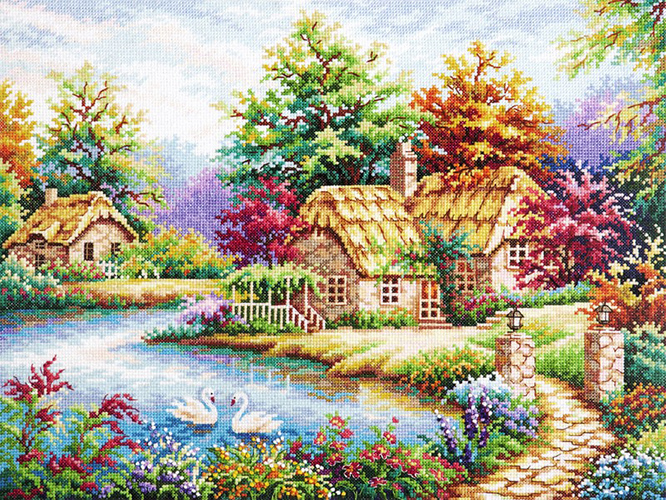
To get started, you just need to purchase the following:
- embroidery base;
- needles;
- cotton or wool colored threads;
- hoop;
- small scissors;
- diagram with image.
In addition, additional accessories may be useful. They are not necessary for beginners, but using these devices makes the work more comfortable and can significantly speed up the process.
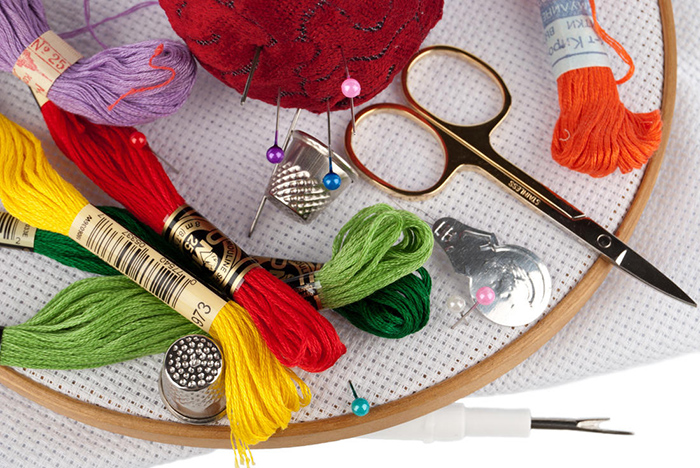
These things include:
- magnifying glass and lamp for needlewomen;
- disappearing or washable fabric marker;
- thread and needle organizers;
- thimble;
- needle threader;
- pincushion;
- seam ripper;
- craft box.
Beautiful cross stitch kits in the manufacturer's branded packaging are usually equipped with all the necessary accessories for work. Additionally, it is enough to purchase only a hoop and you can start creating a picture.
Selecting a design for embroidery
As a rule, beginning embroiderers use ready-made patterns and drawings. Due to lack of experience, it is sometimes difficult for them to evaluate all the nuances and "pitfalls" of the upcoming work, to notice possible difficulties and not to make a mistake when choosing.

First of all, the theme and style of the image should correspond to the interests and tastes of the craftswoman herself or the person for whom the future product is intended.
It is also recommended to be guided by the following selection criteria:
- purpose of the embroidered work;
- complexity of execution;
- size;
- availability of necessary materials and tools;
- level of skill and special skills;
- estimated time costs.
The choice of the plot largely depends on who or what the product is intended for. Thus, to decorate a child's room, you should choose bright and colorful images that are close and understandable to the child. You can embroider a scene from a familiar fairy tale, cartoon characters or funny animals.
Women's clothing will be decorated with flowers, leaves, birds, geometric patterns. It should be borne in mind that in such works, the composition and color scheme of the image play an important role. Ornamental motifs, embroidered edging or borders of flowers and plant motifs will look appropriate on curtains, tablecloths, towels.
The complexity level of the scheme depends on several factors:
- number of colors;
- using blends (connecting threads of different colors);
- the presence of closely related color shades;
- the size of the future embroidery;
- levels of detail;
- combining various embroidery techniques – backstitch (a thin stitch for creating contours and small details), “French knots”, beaded elements, and so on.
Beginner needlewomen should choose small designs and embroider them on medium-sized canvas. If this is the first work, it is desirable that the number of colors does not exceed 15-18 names.
Often, patterns are developed for threads and canvas of a certain company or for a specific type of material. For example, only for woolen threads or for even-weave canvas. Work done using other materials may differ significantly from the expected result, and in some cases, embroidery can simply be ruined by the wrong choice.
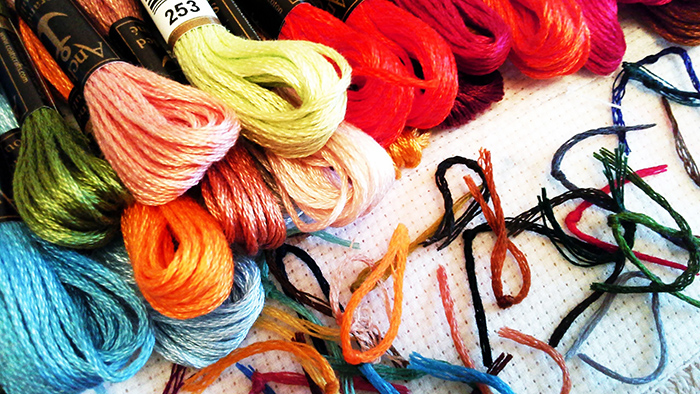
You should learn to correlate your skill level with the degree of complexity of the embroidery work. Inexperienced needlework lovers should be careful when undertaking paintings and panels in mixed media.
At first, it is better to master all the subtleties and nuances of cross stitching, and only then introduce elements of other embroidery techniques or additional materials into your work.
It should also be taken into account that a high degree of skill requires working with a large number of color shades. Complex embroideries include 100 - 150 colors, and some even more than 200.
To make the image realistic, needlewomen use threads of very close, often barely distinguishable, shades. In such cases, the embroidery process requires a lot of experience, a developed sense of color perception and concentration.
Finally, when choosing a design for a future painting, it is necessary to at least roughly imagine how much time can be spent on the work. If the embroidery is intended as a gift for a certain date, the craftswoman needs to determine whether she will be able to finish it on time.
In turn, the speed of work depends on many factors:
- handicraft experience;
- product size;
- technological features and difficulties;
- quality of materials and tools;
- availability of free time.
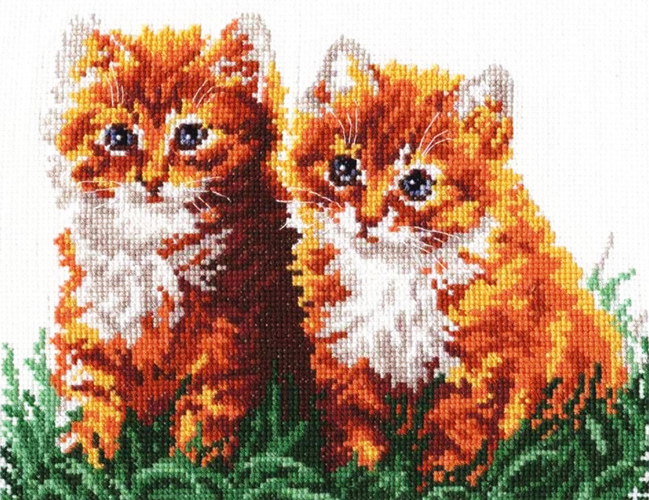
Taking into account the above criteria for selecting an image and a scheme will help to avoid insurmountable difficulties and disappointments in the process of work.
Selecting canvas and threads
Beautiful cross stitch kits include canvas and threads in the required quantity. Many manufacturers supply kits with pre-cut threads on organizers, which makes the work process easier.
If a needlewoman is going to create a picture, having only a pattern in hand, she will have to independently select the base and threads to implement her creative idea.
Canvas is a special fabric for embroidery with a clear and even interlacing of threads and clearly visible holes between them. The size of the finished image depends on the distances between the "cells" - holes and their size. The smaller and closer they are to each other, the smaller the embroidered pattern turns out.
The size of a canvas is determined by its count. Count (ct) is a unit of measurement of the number of holes that fit in 1 inch (= 2.54 cm). The canvas number next to its name indicates this value.
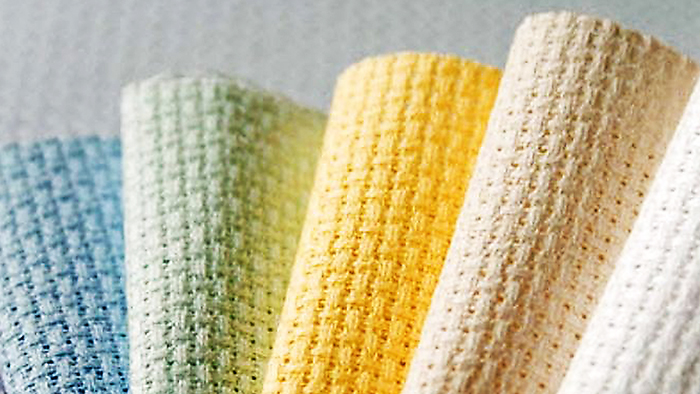
Aida canvas is the most popular base among embroiderers. However, depending on the visual and technological features of the work, as well as due to personal preferences, craftswomen use other types of bases.
The table below contains the most popular types and kinds of canvas suitable for creating paintings:
| Type | Varieties | Count | Compound | Peculiarities | Manufacturers |
| Aida | White, colored monochromatic, with markings, "vintage". | 14, 16, 18, 20 | Cotton 100% | The interlacing of the threads is 4x4. The count depends on their thickness and the density of their adhesion to each other. | Germany (Zweigart),
Russia ("Gamma"), China (Bestex), Denmark (Permin), Hungary, Belarus. |
| Evenweave fabric (so-called "evenweave") | Bellana | It has a dense texture without pronounced holes. | Cotton – 52%,
viscose – 48%. | Contains 20 threads per inch. Avoid overtightening when working. | |
| Lugano 25 | Contains 25 threads per inch. | ||||
| Linda 27 | Cotton 100% | Contains 27 threads per inch. | |||
| Flax | Newcastle | Usually the work is done through 2 threads, which corresponds to a count of 40. | Flax 100% | Contains 160 threads per 10 cm. | |
| Edinburg | Embroidery through 2 threads corresponds to the canvas
Aida 18. | Contains 140 threads per 10 cm. | |||
| Dublin | The fabric is ideal for needlewomen embroidering on linen for the first time. | Contains 100 threads per 10 cm. |
The beauty of cross stitch largely depends on the quality of the threads. If the work is not done using a ready-made set, but only a pattern, the craftswoman will have to select them herself.
It is necessary to take into account the diversity of the color palette. For complex multi-color works, it is recommended to choose a manufacturer whose range includes more than 400 colors and shades. This will help to achieve smooth color transitions and the effect of a real painting.
In addition to the color range, you should pay attention to the quality of the threads. They should be durable, resistant to moisture and sunlight. The thread should not twist or fluff during work.
Mouline threads are ideal for creating embroidered pictures, as they have a wide range of colors and shades. They are made from various raw materials: cotton, wool, acrylic, silk and other plant and artificial fibers.
Most craftswomen prefer to use cotton floss for works based on paintings. They do not slide like silk, and the images are more elegant and realistic than when embroidered with woolen threads.
The highest quality products are made in France, Great Britain and Germany. The floss produced in these countries is the most popular among serious needlewomen. However, due to the high cost, not everyone can afford to buy such threads.
A good alternative could be Russian-made threads. They also have a wide range of colors, but are slightly inferior in quality. Their cost is 2-3 times lower than that of European floss.
It is also easy to find materials made in China on sale. However, their quality is quite ambiguous and is considered a matter of chance among needlewomen. Along with relatively good products, you can come across outright defects in the form of fragile, low-quality or unstable colored threads.
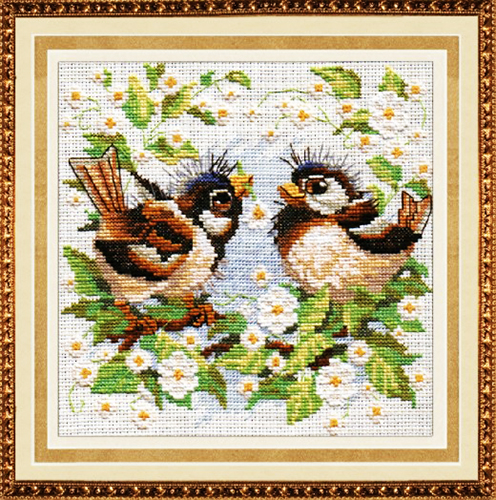
In addition, even threads from the same manufacturer, but from different batches, can differ significantly in shades. This complicates or even makes the embroidery process impossible if during the work there is not enough thread and it is necessary to buy more.
Below are the most popular names of floss threads. The number of colors is given approximately, since new shades appear in each palette every year, and some, on the contrary, are discontinued.
| Name | Country of origin | Number of colors |
| DMC | France | 465 |
| Anchor | United Kingdom | 441 |
| Madeira | Germany | 369 |
| Finca | Spain | 262 |
| Gamma | Russia | 550 |
| PNK named after Kirov | Russia, Saint Petersburg | 550 |
| Bestex | China | 398 |
Threads and bases of the above manufacturers are the most popular materials for embroidery. However, the range is not limited to the above list. There are other manufacturers whose products are readily used by needlewomen.
The choice of materials depends on their availability in a particular region, price, features of a particular handicraft project, as well as the creative tasks and personal preferences of each craftsman.
Beautiful ready-made cross stitch kits
Beautiful cross stitch kits are developed by professional designers taking into account the qualitative and quantitative composition of materials. Kits created based on famous paintings are in great demand among experienced embroiderers. Below are detailed descriptions of some of them.
Blossoming almond
The plot is based on a painting by the Dutch artist Vincent van Gogh, created in 1890. The original title of the canvas is "Blossoming Almond Branches". This is one of the artist's last works, written under the influence of Japanese painting.

This set was developed by the Russian company "Riolis".
The set includes:
- white Aida canvas No. 14;
- woolen floss threads of 26 colors;
- color diagram and instructions;
- needle.
The undoubted advantage of this kit for needlewomen with little experience is the absence of any additional embroidery techniques: backstitch, "French knots", half-cross and others. The entire picture is done with a regular counted cross, full stitching.
The size of the finished work is 40x30 cm. Thanks to these features, "Blossoming Almond" can be a great start for persistent beginners who have decided to throw themselves a creative challenge. Such embroidery can be designed as a picture, a panel, and also used to decorate a sofa cushion or a handmade bag.
The cost of this set is from 1000 to 1300 rubles.
The Ninth Wave
The painting of the same name by the marine artist Ivan Aivazovsky can be called without exaggeration one of the most famous masterpieces in the world. It was created in the mid-19th century and is currently housed in the State Russian Museum in St. Petersburg.
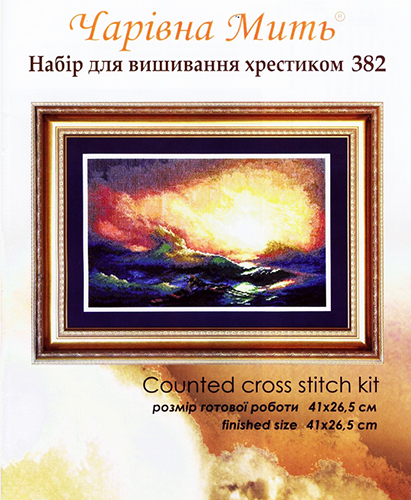
The embroidery design was developed by the Ukrainian manufacturer "Charivna Mit".
The set consists of:
- white Aida canvas No. 14;
- cotton threads floss PNK im. Kirov - 28 colors;
- color symbolic diagram and instructions;
- needles.
The pattern is divided into 4 equal sectors, which greatly simplifies the process of embroidery. The instructions, along with the thread numbers included in the kit, indicate 3 alternative options for working with threads from other manufacturers: DMC, Ariadna and Anchor.
In addition to pure colors, 9 blends are used to create the painting, that is, mixed colors from two different threads. Thanks to this, all color transitions and shades look smooth and natural, creating the illusion of a real painting.
The size of the finished painting is 41 cm in width and 26.5 cm in height. Such a painting will look harmonious in the interior of a living room, study, dining room or office. The cost of this set is on average 900 - 1100 rubles.
The Road in the Rye
The canvas by the outstanding master of landscapes I. I. Shishkin depicts a rye field stretching to a distant but clear horizon line. The field is cut by a winding road along which a lone traveler wanders with a knapsack on his shoulders and a staff.
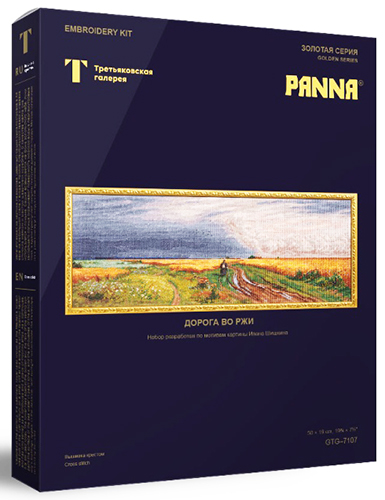
It is noteworthy that panoramic images are almost never found in the works of this artist, which makes this painting doubly attractive to connoisseurs of painting. The set is part of the so-called "Golden Series" of the company "PANNA", which includes the most complex and unusual designs.
In a cardboard package with a landscape image, needlewomen will find:
- white Aida canvas No. 16 from the Gamma company;
- floss threads on organizers;
- black and white diagram with instructions;
- needle.
This design development is addressed to experienced embroiderers, as it will be necessary to work not only with a large number of pure colors, but also with blends. To create a picture with a counted cross, 40 colors of floss and 15 blends are used. The work also uses the "half-cross" and "backstitch" techniques. The size of the finished picture is 50 cm wide and 19 cm high.
This landscape looks great in a home or office interior, and can also be an exquisite and original gift for an anniversary or housewarming. The approximate price of the set is 1800 - 2000 rubles.
Flowers in a glass vase
Beautiful cross stitch kits from the Dutch company "Thea Gouverneur" are distinguished by their rather high prices on the handicraft market. However, the quality of the designer's work and the materials used, as well as the aesthetic pleasure from the work process, justify the cost.
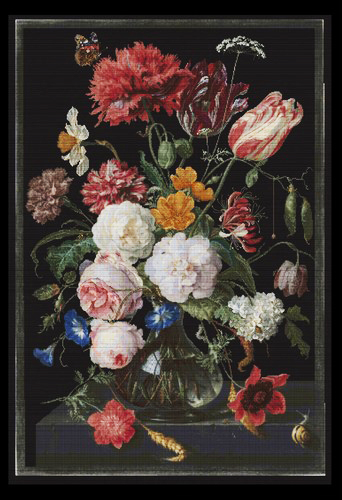
A luxurious still life with a careless multi-colored bouquet, herbs, greenery and a butterfly belongs to the brush of the 17th-century Dutch artist Jan Davidsz de Heem. The painter became famous thanks to his compositions of flowers, insects and fruits, which were distinguished by their original color scheme and meticulous detailing.
The configuration of this set is somewhat variable.
- As a base, the manufacturer offers several options to choose from: black or white Aida No. 18, or linen of 32 count.
- DMC floss – 138 colors on cardboard organizers.
- Symbolic black and white diagram on 16 sheets with explanations in English.
- Description in several languages, including Russian.
- Needle from the company "John James".
Unlike most works, which are done in 2 threads, this picture is embroidered in one thread. The size of the embroidery is 72 cm in height and 49 cm in width. The cost of this set is 8500 - 9000 rubles.
Spring of Lovers
The French artist Pierre Auguste Cot painted the painting "Spring" in 1870, and it gained wide popularity three years later, after participating in a Paris exhibition.

According to one version, the artist was inspired to create this plot by the characters of the Greek novel Daphnis and Chloe. According to another version, it was the heroes of the French sentimental parable Paul and Virginia. This romantic design was created by the famous Moldovan company "Luca-S".
The set consists of:
- light beige lined canvas Aida No. 18 from the company "Zweigart";
- cotton threads floss "Anchor";
- black and white scheme;
- needles;
- instructions.
Despite the lack of mixed colors and backstitch technique, the work is classified as complex. The effect of "real" painting is achieved through fine embroidery using 50 colors.
A big plus of this development is the convenient black and white scheme. The arrangement on 16 sheets and large icons significantly facilitate and speed up the embroidery process.
The size of this large picture is 36.5 cm by 59.5 cm. Such a plot will add a romantic note to the interior of a bedroom or a small cozy living room. Also, a hand-embroidered couple in love on a swing can become an original wedding gift. The cost of the set is 3000 - 4000 rubles.
Beginners in needlework should first master the technique and various methods of cross stitching. Small but nice images of animals, birds, flowers, insects, ornaments or small compositions are suitable for this purpose. Only after this can you start working on large multi-colored sets based on paintings.
Author: Veronica Reutova
Video about embroidery kits
Top 15 Most Expensive Cross Stitch Kits:
